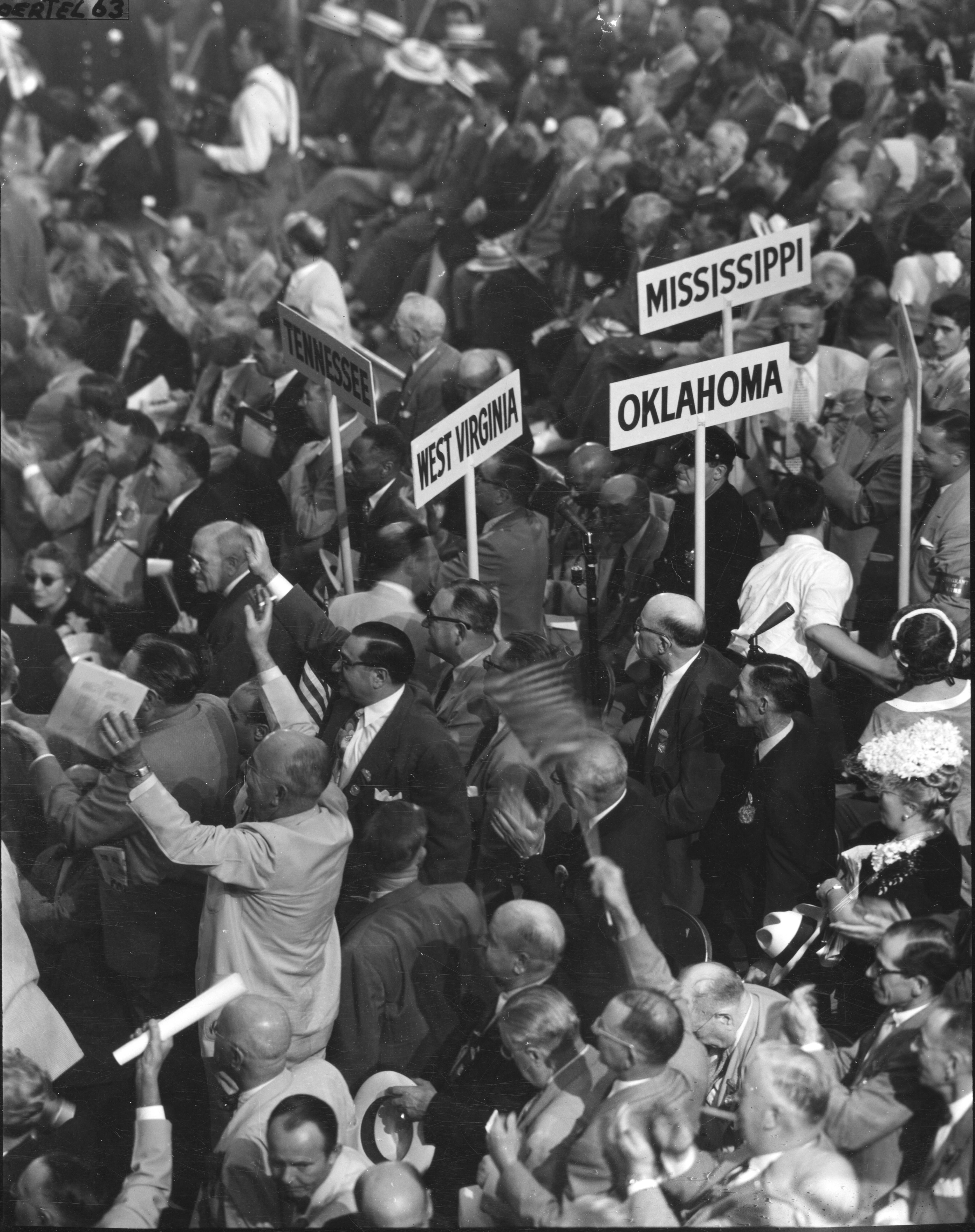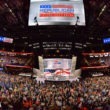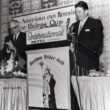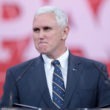Photo Credit: Thomas J. O’Halloran, U.S. News & World Report Magazine
When the end finally came, I felt like crying: first Ted Cruz, then John Kasich, pulling out of the presidential election, denying a political historian like me the keys to a bona fide time machine. I refer, of course, to what the Quicken Arena in Cleveland might have become at the Republican convention in July: a “contested convention.” Ted Cruz, combined with John Kasich—still sending me imploring emails only hours before his exit (“We’re up to 16 polls in a row that show I’m the only candidate who can defeat Hillary Clinton!”)—would deny Trump the required majority on the first ballot, then they could fight to hook, crook, or crowbar enough Trumpophobic delegates into their column to emerge with the prize. It was to be the political spectacle of the millennium.
Then, tragically, no soap.
No smoke-filled chaos, no convention stretching out to 10 days, no fisticuffs over obscure procedural fights, no riots. Someone, somewhere, within the Republican financial and/or political establishment managed to prevail upon the holdouts to give up. And when you review the madcap history of contested conventions, you can see why.
National conventions, you see. . .
We scratch our heads in bafflement now, but this sort of thing used to be routine—back before most of us were born. National party conventions used to be actual decision-making bodies: great clanking behemoths of deliberative democracy. Or, more accurately, “democracy.” In an era before the widespread adaptation of primary elections to choose delegates and bind them to candidates, some towering party personage, usually a governor, would get declared a “favorite son” presidential candidate, with all his party’s delegates pledged to vote for him. Then, with great fanfare, he would “release” his bloc to one candidate—in exchange for the proper ideological blandishments or material emoluments, arrived at in proverbial smoke-filled rooms.
It was a set-up tailor made for nail-biting drama. In 1924, the first year the proceedings were broadcast live, political junkies gathered ‘round the radio to follow along, hoping for a repeat of 1920, when it took 44 ballots to nominate Ohio governor James M. Cox. They were hardly disappointed: this time, a Democratic Party at loggerheads over prohibition and the Ku Klux Klan, took eight days and 103 ballots to settle upon John W. Davis of New York.
Exciting? Hell, even the Wikipedia account of the tenth ballot “when Kansas abandoned Gov. Jonathan M. Davis and threw its votes to McAdoo” is sexy. “There was an instant uproar among McAdoo delegates and supporters, and a parade was started around the hall, the Kansas standard leading, with those of all the other McAdoo states coming along behind, and pictures of ‘McAdoo, Democracy’s Hope,’ being lifted up. After six minutes the chairman’s gavel brought order and the roll call resumed, and soon the other side had something to cheer, when New Jersey made its favorite son, Gov. George S. Silzer, walk the plank and threw its votes into the Smith column. This started another parade, the New York and New Jersey standards leading those of the other Smith delegations around the hall while the band played ‘Tramp, Tramp, Tramp, the Boys are Marching.’”
One trembles to imagine what CNN would make of all that.
One of the reasons the Democratic conventions back then were so nuts was that party rules demanded a nominee secure not just a majority of delegates but two-thirds, in order to give Southern states an effective veto over any candidate who dared feint toward undoing the region’s authoritarian system of racial terror. The two-thirds rule was dissolved in 1936, which didn’t dissolve convention drama. At the Chicago Stadium in 1940, the incumbent president glided to a controversial third nomination after a mysterious voice—it belonged to the city’s superintendent of sanitation, stationed at a microphone in the building’s bowels—boomed at just the right moment: “We want Roosevelt! We want Roosevelt!”
What history remembered as the “voice from the sewers” signaled the “spontaneous” demonstration that launched FDR to a resounding first-ballot victory.
Right-wing delusions
Thereupon, however, nearly all the interesting convention melodrama belonged to the Republicans, thanks, in part, to the increasing confidence, power—and paranoia—of the party’s conservative wing. Mastering and manipulating the dark arts of convention skullduggery became ingrained in the American right’s DNA. The development dates back to the summer of 1952, and if you’re skeptical that something that happened in the age of the DeSoto and the icebox isn’t still lubricating the right-wing imagination, just read this this dubious primer published last month in the National Review, which re-mythologizes the battle between the “liberal” Dwight D. Eisenhower and conservative Senator Robert Taft as if it happened yesterday.
Dubious, because: the pivotal delegation that year was Texas, which had only a paper party, existing solely for the purpose of accruing and cashing in on lucrative patronage bounty by delivering its delegates to the winner in some far-off city every four years. They called such Southern Republican organizations “post office parties,” and used to joke that there were hardly enough Republicans in Mississippi/Alabama/Georgia to fit in a phone booth.
Anyway, in 1952 it emerged that there were enough Texans who actually wanted a Republican—General Eisenhower—to win the presidential election that they signed up as Republicans to participate in the local and state GOP conventions. Conservatives who worshiped Robert Taft, aghast at this outbreak of democracy in the Lone Star State, literally marched into Chicago’s International Amphitheater singing “Onward, Christian Soldiers.”
(About half the national party conventions to that point were held in Chicago: easy to get to by train. Lots of deal-making in railroad “smoking cars,” too.)
Conservative Republicans left the convention decrying a perfidious “Texas Steal,” effected by supposedly bought-and-paid-for “Republicans for a day.” The event became Ground Zero for a thousand conspiracy theories about the Republican “establishment” exploiting conventions to thwart the will of the “grassroots.” Here’s Phyllis Schlafly, in her book on the subject, A Choice Not an Echo, hallucinating about what she imagined was the only way Eisenhower could possibly have secured the nomination:
The Madison Avenue public relations firms, the big national magazines, and four-fifths of the influential newspapers in the country turned themselves into propaganda organs to build the Eisenhower image. . . . [They] brought about a change in the rules under which every previous Convention had functioned. . . . Taft headquarters received reports of Delegates who were bodily put on the train for home, leaving their alternates to vote for Ike. Delegates were threatened with loss of their jobs and calling of their bank loans unless they voted for Eisenhower. Money flowed in great quantities everywhere [via] the diverse financial contacts of the New York kingmakers. . . . All the vast publicity machine that always goes into concerted action for a liberal cause had gone to work . . . an operation so honed and smoothed and refined over the years that none of its proprietors even had to consult with one another. The instinct had been alerted, the bell had rung, the national salivations had come forth on schedule.
Sheer fantasy, but, as we’ve learned all too well from conservatives in the intervening decades, fantasies have consequences. Comic ones, in the case of 1964, the year Phyllis Schlafly published her imperishable jeremiad. F. Clifton White, the bow-tied leader of the Draft Goldwater movement, always said he learned how to control a convention from the Communists who took over the liberal veterans’ organization he had joined after World War II: how to station a small number of operatives on the floor to make it look like you had a crowd; how to organize cells, small face-to-face groups under the discipline of a single benign dictator; introducing anodyne resolutions as the lulling opening wedge for endorsing accommodation with Stalin; manipulating time, slowing roll call votes that were going against them, then supercharging them once they had the votes; things like that.
And smears: when White ran for chairman of the American Veterans Committee, his adversaries spread a rumor during the balloting—no time to fight it—that he was secretly using AVC funds to furnish a love nest for a mistress.
On the one side we would have had the Mighty Orange-Haired Monster, who had retained as his convention guru one of the architects of Ford’s 1976 victory, Paul Manafort. On the other side we had Lucifer in the Flesh, a pure product of conservative culture.
And steady, patient organizing, beginning at the dewiest grassroots: thus could a single small organization, from a distance and working with minimal resources, working in stealth, take over an organizational Goliath.
By the time the 1964 convention rolled around, the Goldwaterites had far more loyal delegates than needed for a first-ballot victory. But they were taking no chances: the Establishment, after all, was wicked and cunning.
“The 1952 tricks will be used again,” the Goldwater campaign treasurer warned in a memo: “planted ‘bum dope’ stories”; “whispering campaigns”; “threats and cajolerly”; “shanghaiing and spiriting of delegates and alternates to distant points”; “political Mata Haris.” “Be on the lookout for any unexpected easy companionship from new-found female friends.”
Comic, and not so comic: in the right-wing imagination, you always have to do it to them before “they” do it to you. Even if what “they’re” up to is but a figment of your imagination. So it was that in 1972, G. Gordon Liddy laid plans to park a yacht offshore for the 1972 Democratic convention in Miami Beach—in order to kidnap Democratic delegates and officials or entrap them with prostitutes. “I recall Liddy saying that the girls would be high class and the best in the business,” John Dean testified to the Senate Watergate Committee the following year.
But back to 1964. As I wrote in Before the Storm: Barry Goldwater and the Unmaking of the American Consensus, beginning three months before the convention, White created an awesome political command-and-control apparatus to police possible wayward delegates:
As they were named through the spring, White had his state chairs assign each delegate a buddy, whom they were to contact at least once a week to develop a bond—and the buddies were to travel together at all times in San Francisco lest either be led into temptation. The airport was a vulnerable flank. When they arrived at San Francisco International, delegates were to report immediately to the Goldwater hospitality room, where staffers would contact headquarters at the Mark [Hopkins Hotel], where the delegates’ arrival was noted in the pages of big black cross-indexed loose-leaf binders which contained intelligence on each of them (“Can be influenced and expect economic pressures can be important when the chips are down. He also is actively and economically involved in real estate in Arizona, has made several trips there in the last few years.”) Neither were they to trust the transportation the RNC was providing. They would be spirited to their delegation’s hotels . . . by radio-equipped cars. The routes had been timed, so if a delegate was tardy, an APB could be put out. . .
It all was ridiculous. Most of Goldwater’s delegates would sooner have slit their wrists and bled out on the convention floor than betray the holy cause. But that’s the point: a key element of conservatism, as a culture, is the conviction that civilization is ever at the verge of collapse, and nothing is out of bounds in order to prevent that collapse.
Defense and Offense
Now, there is convention defense, and there is convention offense. And when I heard the news late last month that a deal might be in the works between Ted Cruz and John Kasich to join forces to deny Trump a nomination on the first ballot and then to fight it out between themselves, my thoughts turned to a classic example from the distant past.
The Republican convention in 1968. Late innings, both Governors Nelson Rockefeller of New York and Ronald Reagan of California had decided heir apparent Richard Nixon did not deserve the nod, Rockefeller because he thought Nixon too conservative and Reagan because he thought him too liberal. Rockefeller announced on April 30, past the deadline to enter any primaries; Reagan announced, incredibly, at the convention. But both, that spring and summer, expended great effort plying closed meetings of convention delegates.
Comic, and not so comic: in the right-wing imagination, you always have to do it to them before “they” do it to you. Even if what “they’re” up to is but a figment of your imagination.
The key was the South, that most undemocratic of regions, which South Carolina Senator Strom Thurmond’s top political aide Harry Dent had schemed to take to the convention as a voting bloc. Both campaigns acceded to the notion, each confident they could catch the “tipped football”—if their combined vote could deny Nixon that crucial first ballot 50-percent-plus-one, thus throwing the convention into a bobbling disarray.
It wasn’t to be. Nixon cut a deal with Thurmond for his endorsement in exchange for promises like not enforcing civil rights laws; Rockefeller had already biffed his infinitesimal chances of charming Dixie, allegedly when at one Southern cigar-choked breakfast, he committed the mortal culinary sin of pouring sugar on his grits. (You think this crap started with Barack Obama and arugula?)
After Hubert Humphrey won the Democratic nomination without entering a single primary, at a convention that broke out in brawls both inside and outside the convention hall, and then promptly went on to lose the election to Nixon, the Democrats empaneled a commission to reform their nomination process to replace the smoke-filled rooms with, mostly, primary elections.
Republicans, taking stock of the political winds, mostly followed suit. It seemed the smoke-filled rooms—and the dark arts of convention manipulation—were a thing of the past.
One last hurrah
Except for that one last hurrah.
In 1976, conservatives, ever alert for signs of civilizational collapse, somehow managed to frame poor Gerald Ford as a liberal quisling, and lined up behind Ronald Reagan’s nearly unprecedented challenge to a sitting president of his own party, which he fought almost to a tie.
But the small number of undecided, unpledged delegates the reformed nomination system still allowed was greater than the 86 votes Reagan needed to surpass Ford.
Those delegates became veritable celebrities; one, Sherry Martschink, was profiled in The New York Times. The president showered them with inducements only a president could: invitations to state dinners, ride-alongs on aircraft carriers, pledges of sewer system upgrades. When Gerald Ford arrived in a city for a ribbon cutting, Reagan joked ruefully, the band didn’t strike up “Hail to the Chief,” it played “Santa Clause is Coming to Town.” Yet Reagan offered blandishments of his own, like audiences with his glamour-puss pals like Jimmy Stewart—and John Wayne (who thought “Jerry Ford is too fucking dumb to be president”).
And at the convention—the “Shootout in Kansas City”—the old conservative playbook was busted out once more. The doings were insanely complicated, as a deliberative process involving thousands of participants must necessarily be. Ford state floor whips wearing red baseball caps and “floating” floor whips wearing yellow; a mutiny from the right in the Reagan camp; something called “rule 16-C” to require all candidates to name a running mate early, which for reasons too occult to explain was adduced as the voodoo that might force the last-minute tip of the football from Ford to Reagan. And then the floating of a possible second conservative challenger in the person of Senator James Buckley, William F.’s brother, as a final Hail Mary should that first one not succeed; the breaking of communications lines between Ford headquarters and their crucial New York delegation by a Utah delegate who ripped a phone out of the floor; a flanking maneuver to manufacture the appearance of an unbreakable tide toward Ford that involved, yes, the First Lady dancing in the aisles with “Tie a Yellow Ribbon” singer Tony Orlando in order to counter the effects of the Texas delegation’s infernal air horns, the Voice from the Sewer of ’76.
No joke: it defies summary, and you’ll need to consult the 35 packed pages in my most recent book to make full, or even half, sense of the chaos. Let one scene, however, stand in for many: a vote within the Mississippi delegation over whether to count its delegates individually (which would advantage Reagan) or as a block (which would advantage Ford). Intelligence concerning that particular flap of the butterfly’s wing was so tactically sensitive at that critical moment in the madness the state party’s young executive director Haley Barbour started reciting the names of Mississippi’s 82 counties in alphabetical order, Adams to Yazoo, then in reverse, Yazoo back to Adams, to keep the other side from listening in.
That was what a political convention used to be.
Then came what historian Alan Brinkley dubbed “The Taming of the Political Convention”: “sterile, stage-managed media events—created for television, but so empty and artificial that even television has little interest in them.” They “survive, for most viewers, as televised advertisements for presidential campaigns.”
Then, suddenly, it felt like what’s old would be new, and the campaigns might be de-mothballing a Hogwarts’ library worth of esoteric knowledge to prepare to play this game once again.
On the one side: the Mighty Orange-Haired Monster, who had retained as his convention guru one of the architects of Ford’s 1976 victory, Paul Manafort, who, of little use in a modern political convention, had turned to clients like Angolan guerrilla-politico Jonas Savimbi and Viktor Yanukovych, the former criminal president of Ukraine.
Oh, and Trump also signed up Roger Stone, who promised an SDS-style “#DaysofRage” street riot if the “Establishment” dared to deny his man the prize.
On the other side we had Lucifer in the Flesh, a pure product of conservative culture, more steeped in its lore and legend including how to steal and un-steal conventions than any presidential prospect in modern times (unless, that is, I make good on my promise to run in the New Hampshire primary in 2020).
And now it’s gone.
Damn you, Ted Cruz!
Yes, going in, you would have had only half as many delegates as the leading candidate. But so did James M. Cox in 1920.







Wonderful. Thanks.